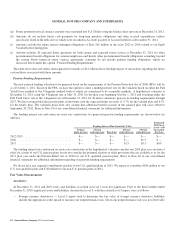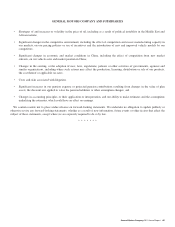General Motors 2011 Annual Report Download - page 64
Download and view the complete annual report
Please find page 64 of the 2011 General Motors annual report below. You can navigate through the pages in the report by either clicking on the pages listed below, or by using the keyword search tool below to find specific information within the annual report.GENERAL MOTORS COMPANY AND SUBSIDIARIES
calculating the fair values of our more significant reporting units during our 2011 annual goodwill impairment testing, keeping all
other assumptions constant, the estimated fair values of our more significant reporting units would still exceed their carrying amounts
had our WACC increased by 150 basis points for GMNA, 410 basis points for Holden and 430 basis points for GM Mercosur. For
GM Financial, fair value would still exceed its carrying amount had equity to managed assets retention ratio increased 230 basis
points by 2014.
Based on the fair value measures determined during our 2011 annual and event-driven impairment tests we determined the fair
values of those reporting units requiring a Step 2 analysis (GME, GM Korea and Holden) had not increased sufficiently to give rise to
an implied goodwill amount other than the goodwill arising from the fair value-to-U.S. GAAP differences attributable to those assets
and liabilities that gave rise to goodwill upon application of fresh-start reporting.
The key assumptions utilized in determining the fair value-to-U.S. GAAP differences giving rise to the implied goodwill for the
reporting units requiring a Step 2 analysis are the determination of our nonperformance risk, interest rates, estimates of our employee
benefit related obligations and/or the estimated timing of the utilization of our deferred tax assets, including our determination
whether it is more likely than not that the deferred tax assets will be utilized. Of these factors, the amount of implied goodwill within
GME is most sensitive to changes in our nonperformance risk, interest rates and estimates of our employee benefit related obligations.
GM Korea and Holden are most sensitive to our determination of whether it is more likely than not that their deferred tax assets will
or will not be utilized.
In the future, we have an increased likelihood of measuring goodwill for possible impairment during our annual or event-driven
goodwill impairment testing and in evaluating whether it is more likely than not that a goodwill impairment exists for reporting units
with zero or negative carrying amounts. An event-driven impairment test is required if it is more likely than not that the fair value of a
reporting unit is less than its carrying amount. Because our reporting units were recorded at their fair values upon application of fresh-
start reporting, it is more likely a decrease in the fair value of our reporting units from their fresh-start reporting values could occur,
and such a decrease would trigger the need to measure for possible goodwill impairments. GME has a negative carrying amount and
GM Korea’s fair value is less than its carrying amount, which increases the likelihood of measuring goodwill for further impairment
in the near-term.
Upon the application of fresh-start reporting goodwill predominately resulted from our recorded liabilities for certain employee
benefit obligations being higher than the fair value of these obligations because lower discount rates were utilized in determining the
U.S. GAAP values compared to those utilized to determine fair values. The discount rates utilized to determine the fair value of these
obligations were based on our incremental borrowing rates, which included our nonperformance risk. Our incremental borrowing rates
are also affected by changes in market interest rates. Further, upon the application of fresh-start reporting, the recorded amounts of our
assets were lower than their fair values because of the recording of valuation allowances on certain of our deferred tax assets. The
difference between these fair value-to-U.S. GAAP amounts (1) would decrease upon a decrease in credit spreads between high quality
corporate bond rates and market interest rates for companies with similar nonperformance risk; (2) could decrease upon an
improvement in our credit rating, thus resulting in a decrease in the spread between our employee benefit related obligations under
U.S. GAAP and their fair values; and/or (3) could decrease upon a change in the fair values of our estimated employee benefit
obligations. A decrease will also occur upon reversal of our deferred tax asset valuation allowances. Should the fair value-to-U.S.
GAAP differences decrease for these reasons, the implied goodwill balance will decline. Accordingly, at the next annual or event-
driven goodwill impairment test, to the extent the carrying amount of a reporting unit exceeds its fair value or the reporting unit has a
negative carrying amount, a goodwill impairment could occur. Future goodwill impairments could also occur should we reorganize
our internal reporting structure in a manner that changes the composition of one or more of our reporting units. Upon such an event,
goodwill would be reassigned to the affected reporting units using a relative-fair-value allocation approach, unless the entity was
never integrated, and not based on the amount of goodwill that was originally attributable to fair value to-U.S. GAAP differences that
gave rise to goodwill upon application of fresh-start reporting.
Refer to Note 12 to our consolidated financial statements for additional information on goodwill impairments, including risks of
future goodwill impairment charges.
62 General Motors Company 2011 Annual Report
























